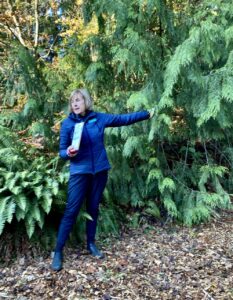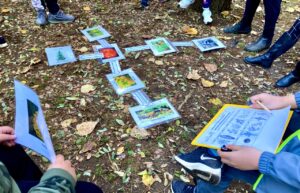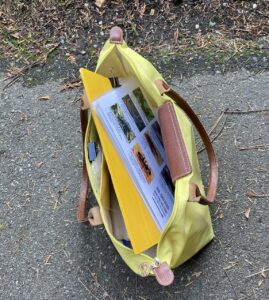Written by Penny Williams, Volunteer Writer
Volunteer Norma Serka, a Field Trip Guide, is about to take a grade 5 class on one of the last guided Field Trips of the fall season. She gathers the students (plus teachers and parent-chaperones) around her outside the Visitor Centre, announces the Ecosystem Explorers theme, and asks, “What makes up the ecosystem?”
One boy calls out, “Water! Food! Space! Sunlight!” Norma beams agreement, and teaches the group two scientific words: “biotic” (living) and “abiotic” (non-living). She adds, “You’re grade 5, so we can use these words.” It’s a clever, and motivating, compliment — using the children’s pride in being “big kids” to encourage thoughtful participation.
 Away they go, along the edge of Livingstone Lake (with passing discussion about turtles now deep in the oozy lake bottom); into a grove of Douglas Fir (where they learn the distinctive appearance of its cones and play a cone-ID game); and on to the detailed scrutiny of a mossy log near the BC Habitat Garden. Norma sends the students off in pairs, each with a helpful clipboard, to discover all the types of life on the log that justify calling it a “nurse log.”
Away they go, along the edge of Livingstone Lake (with passing discussion about turtles now deep in the oozy lake bottom); into a grove of Douglas Fir (where they learn the distinctive appearance of its cones and play a cone-ID game); and on to the detailed scrutiny of a mossy log near the BC Habitat Garden. Norma sends the students off in pairs, each with a helpful clipboard, to discover all the types of life on the log that justify calling it a “nurse log.”
For the children, it’s a game. For Chantal Martin, the VBGA’s Director, Education, it is an example of “place-based learning” and the way the Youth Programs focuses its environmental education activities.
Field Trips and Camps are the sub-sets of Youth Programs, which in turn is one of the seven components — along with Adult Education, the Library, Family Programs, Teacher Professional Development, Outreach and Visitor Engagement — of the Education Program as a whole.
Field Trips began within a few years of the Garden opening its doors and, except for the COVID interruption, have been active ever since. “We work with the School Boards of the whole Lower Mainland,” says Chantal, “and offer trips from pre-school right through grade 12.”
 Norma’s class has moved on to a new area and a new game. Perched on a large circle of log stumps, they watch her place a photo of the sun in the middle of the clearing. Time for “Ecosystem Connections”; time to puzzle out the relationships from the sun right through the eco-chain here on earth. She hands out photos to the children, everything from trees and birds down to slugs and mould. They guess, build on each other and on Norma’s clues, and then use directional arrows supplied by Norma to lay out the connections.
Norma’s class has moved on to a new area and a new game. Perched on a large circle of log stumps, they watch her place a photo of the sun in the middle of the clearing. Time for “Ecosystem Connections”; time to puzzle out the relationships from the sun right through the eco-chain here on earth. She hands out photos to the children, everything from trees and birds down to slugs and mould. They guess, build on each other and on Norma’s clues, and then use directional arrows supplied by Norma to lay out the connections.
The Pacific banana slug, a bit player in this game, is star of the Field Trip’s final game: “Slug Life Lottery.” Norma shows the students a photo of the adult slug (second-largest land slug in the world and a BC native, she points out), and then a photo of the egg clusters. She gives each child a number identifying them as one of those eggs. As she calls each number, she also announces the fate of that egg — eaten by something! Only one egg lives long enough to reproduce. The lottery-winning student does a little victory jig for his classmates.
Later, back in the Volunteer Lounge, Norma explains what first attracted her to this role. A retired nurse (with teacher training also in her background), she often came to the Garden with her family, and realized it would be a good place to volunteer and indulge her love of being outdoors. Now with almost six years experience leading Field Trips, she says, “It’s challenging, and it’s fun. I’ve learned a lot and I keep learning more.”
“More” is also coming in the Program itself, says Chantal. Fall 2023 will see the launch of seasonal Teachers Kits, which teachers may either buy or borrow from the Library, full of resources they can use to offer a Garden-like experience in the classroom. Also in the works: a Virtual Field Trip experience for the Bloedel Conservatory.
Ask Chantal about the volunteer partnership for Field Trips, and her answer is immediate: “The volunteers are at the heart of it all.”
